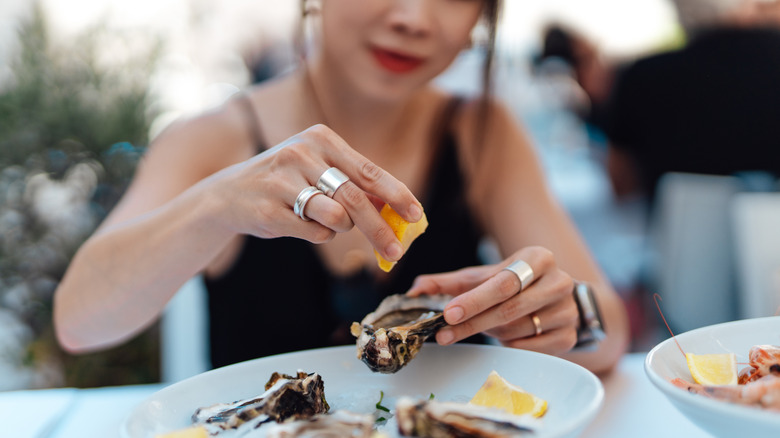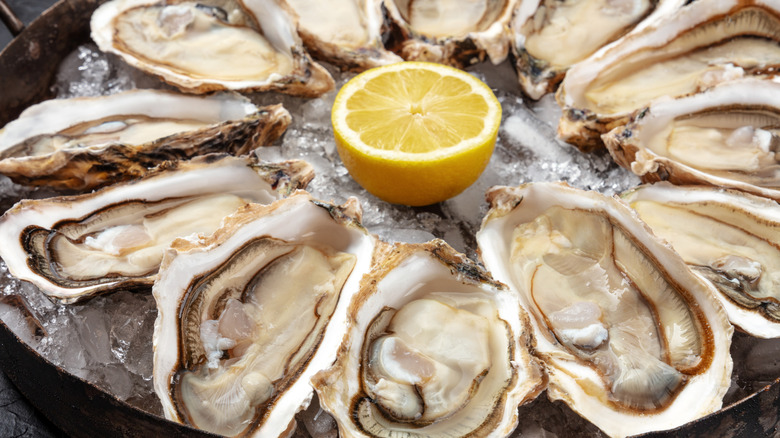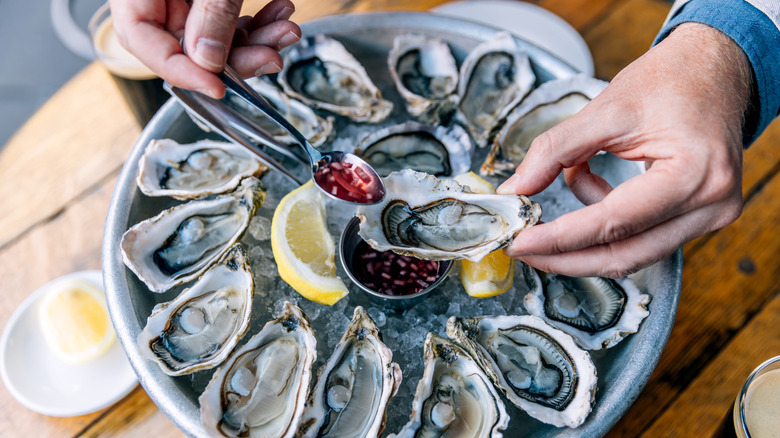Why You Should Avoid Ordering Oysters At A Chain Restaurant
You're perusing the menu at a fast-casual chain when you spot your all-time favorite food — raw oysters. But the chain is known for pizzas, not seafood, and the dishes aren't always the freshest. No, it's not as sketchy as a cruise ship buffet. But is it worth the risk?
The Takeout asked Russell Kook, the former Iron Chef contestant who currently serves as Chef and Culinary Director at The Bellevue Chicago, a Gold Coast restaurant with a seafood-heavy menu. "I would skip oysters at any restaurant you don't feel 100% confident about," says Kook.
Raw oysters are risky: They're basically bacteria traps. Oysters feed off plankton they collect by filtering water through their gills, but germs can get caught in the filter and build up there over time. "Oysters require a high level of care from sourcing, handling, and storing," explains Kook. "If a restaurant isn't working with seafood regularly on a high level, it's hard to guarantee freshness. I would recommend ordering the restaurant's specialties and avoiding the seafood options."
Most of the oysters you see on restaurant dining tables are safe. Even if you do get an infection caused by Vibrio bacteria — the most common cause of oyster-related illness — you'll probably escape unharmed after a day or two in the bathroom. But some strains of Vibrio are more dangerous than others. The V. vulnificus strain — the flesh-eating bacteria that claimed two lives in Louisiana this year — only infects around 150–200 people each year, but the one in five mortality rate still means it's nothing to mess around with
What should you watch out for when eating raw oysters?
Kook warns diners to keep away from menus that say "oysters" and leave it at that. "When a restaurant lists specifics about the oysters, you can take that as a sign that they are offering a higher level of quality," he explains. "You want to see or hear info about the farms, regions, names of the oysters. Restaurants should be proud of where they are sourcing their product and forthcoming of that information."
If you don't see the info on the menu, feel free to ask your server. "Staff should be able to answer questions about the oysters, including details on where they are from, region info, taste, etc.," notes Kook. "They should also be able to give recommendations based on your preferences. You want to know that these oysters are being sourced and served at their peak freshness."
Now, for the bad news: Oysters are getting even riskier. Vibrio cases dipped in the aughts and teens, but climate change is threatening to undo the progress. Vibrio vulnificus is spreading farther and sticking around longer as oceans get warmer. In 2022, infections spiked to the highest point since the '90s. But Kook says that paying attention to the particulars — like whether the oysters are in season — can help you stay safe.
How can you stay safe while eating raw oysters?
"You want to know where the oysters are from," says Kook. "That gives so much info on the taste and their seasonality. When you know where the oysters are from you're better able to tell if they are in season, which is important."
In-season oysters don't just taste better, they also carry less risk. But figuring out whether oysters are in season isn't as easy as checking the calendar. Ever heard that you should only eat oysters in months that end with an R? These days, the 4,000-year-old adage — which was meant to keep people from eating out-of-season oysters — is moot. Now, oysters are imported from around the world. Holding off till November won't do you much good if the shellfish were shipped from the Southern Hemisphere.
Avoiding inexpensive, out-of-season, questionably sourced oysters is the best way to stay safe when eating oysters raw. You can't kill Vibrio with hot sauce, alcohol, or lemon juice, and you won't be able to see, smell, or taste the bacteria, either. People with weakened immune systems, stomach issues, or liver disease should avoid raw oysters entirely. There is one thing that oyster lovers can do to reduce their risk, though: Order oysters baked, grilled, or fried. Properly cooking oysters is typically enough to kill off Vibrio or other nasty germs.


